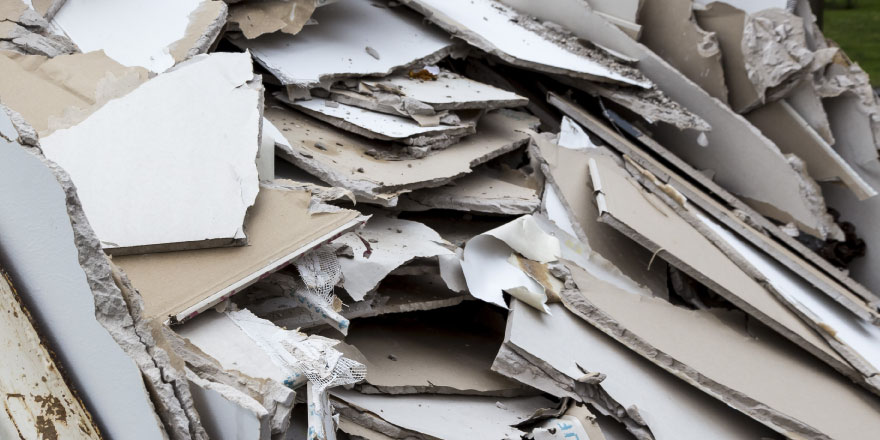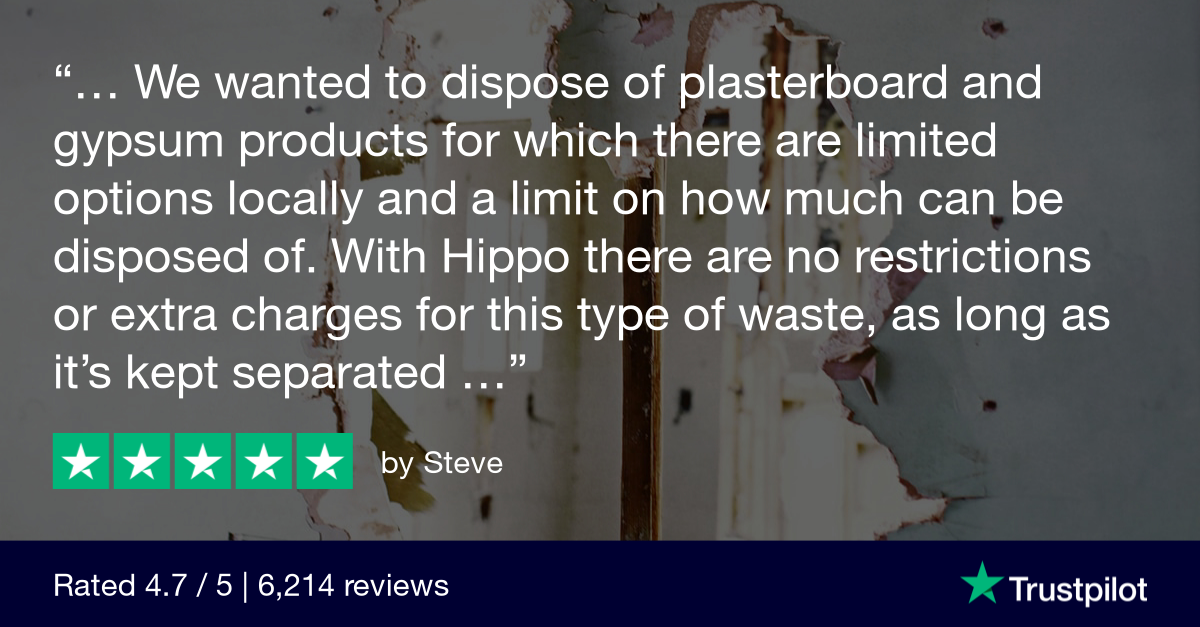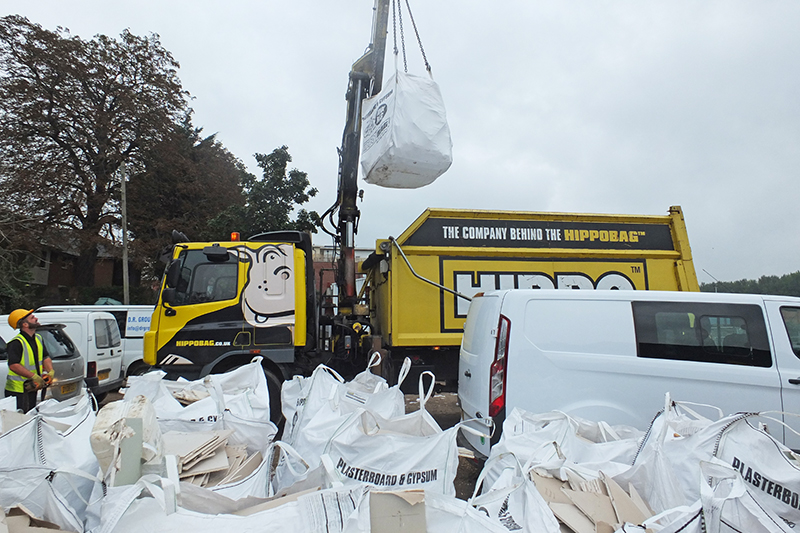Plasterboard Recycling & Disposal

What does the legislation say about plasterboard disposal?
In 2009, the Environmental Agency passed legislation that gypsum-based materials, such as plasterboard, must not be landfilled and that they should be separated for recovery and recycling. The legislation applies whether you are an individual or a large-scale business.
Plasterboard Disposal for Domestic Householders
For individuals, the legislation means you’re required to separate and segregate plasterboard from other waste before heading to your local tip. Alternatively, use a licensed waste carrier like HIPPO (carry on reading to learn how HIPPOBAGs are the perfect solution for recycling plasterboard).

Most local household waste recycling centres (HWRCs) offer plasterboard disposal and recycling but may have restrictions and possibly even charges in place. Check out our useful Tip Charge Checker to see if charges apply in your area.
Plasterboard disposal for businesses
As a business producing large volumes of plasterboard waste, you have a duty of care to keep this waste stream segregated and dispose of it responsibly, or you’ll potentially face fines from the Environment Agency.
Your options for disposal include finding a local plasterboard recycling centre or passing the waste on to a licensed waste carrier, permitted to collect plasterboard.
HIPPO’s plasterboard recycling scheme offers quick and cost-effective collection of gypsum. For no more than the cost of a HIPPOBAG full of mixed waste, you can be reassured that HIPPO’s plasterboard recycling scheme provides you with an effective and efficient collection of gypsum. If you are producing gypsum waste from commercial projects and have larger volumes, contact us to find out what discounts are available – based on 10 MIDIBAGs collected from a single location, this could be as little as £35* per bag.

Do HIPPOBAGs accept plasterboard?
Yes, HIPPOBAGs are an ideal solution for plasterboard recycling. HIPPO accepts plasterboard as long as it's kept clean, segregated, and separated from other waste within your HIPPOBAG. To avoid contamination, plasterboard must be bagged or wrapped separately. If plasterboard mixes with general waste, gypsum breaks down into a powder that becomes difficult to recycle. HIPPO cannot collect bags containing mixed plasterboard and other waste.
We can recycle the following gypsum-based products:
- Plasterboard (including gypsum fibreboard)
- Cove
- Gypsum-based ceiling tiles
- Glasroc
- Artex decorative plaster mouldings
Using HIPPOBAGs ensures 100% of your gypsum waste is responsibly recycled, helping you comply with the Environment Agency regulations.
FAQS
Is plasterboard hazardous waste?
Plasterboard is not classified as hazardous waste; however, it is banned from being disposed of in general waste landfill sites in the UK.
Plasterboard contains gypsum, which, when mixed with general waste, reacts to create a toxic hydrogen sulfide gas.
Gypsum materials, such as plasterboard, should be separated from general waste and recycled or disposed of safely.
How do I dispose of unused plasterboard?
Many local household waste recycling centres accept and dispose of plasterboard, but check before you go, as they may have restrictions or charges in place.
You should separate any plasterboard from any general waste and dispose of it separately.
Alternatively, you can hire a licensed waste disposal company to come and remove the plasterboard for you.
Can you burn plasterboard?
You should not burn plasterboard. Burning harmful household waste can result in thick, odorous smoke, which could travel across roads and cause accidents.
By burning plasterboard, you will release harmful gypsum particles into the air, contributing to air pollution and releasing toxic fumes.
Safely dispose of plasterboard at a household waste recycling centre, or arrange for it to be collected by a licensed waste carrier, where it will be recycled and disposed of correctly.
Can I put plasterboard in a skip?
No, you cannot place plasterboard in a skip.
Plasterboard is banned from being placed in landfills in the UK, and any plasterboard placed within a skip will be refused by the hire company.
When mixed with biodegradable waste, gypsum, a mineral within the plasterboard, creates a toxic and poisonous hydrogen sulphide gas.
Plasterboard can become harmful if placed and disposed of in a skip.
How can I use old plasterboard?
Gypsum is a mineral that is commonly used as fertiliser and compost. Gypsum from plasterboard can also be used in composting products. Most gypsum plasterboard is suitable for composting; however, it should not be painted or coated.
Plasterboard off-cuts can be recycled to create new plasterboard. During the recycling process, the plasterboard is broken down, and the gypsum powder is separated. Recycled gypsum powder is then mixed with new gypsum to create new plasterboard.
If you have excess plasterboard, you can save it for a future project. Keep the plasterboard flat in a waterproof location. If the plasterboard becomes wet, it cannot be salvaged again once dry and will need replacing.
Responsible Recycling and Disposal of Plasterboard
HIPPO is a responsible business which conforms to the legislation and also actively pursues partnerships with waste recycling centres that share our commitment to recycling.
No matter how much household or garden waste you need to dispose of, our range of HIPPOBAGs, Skip Hire and Man & Van services means that there’s always a convenient, cost-effective and reliable rubbish removal solution that works for you.

